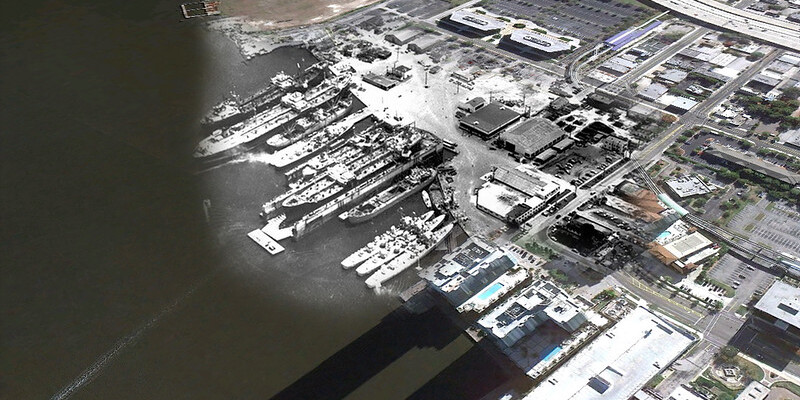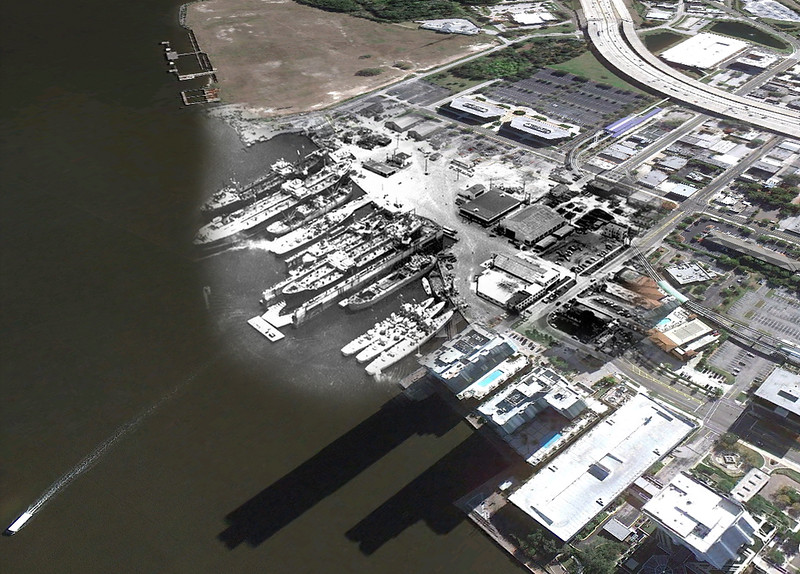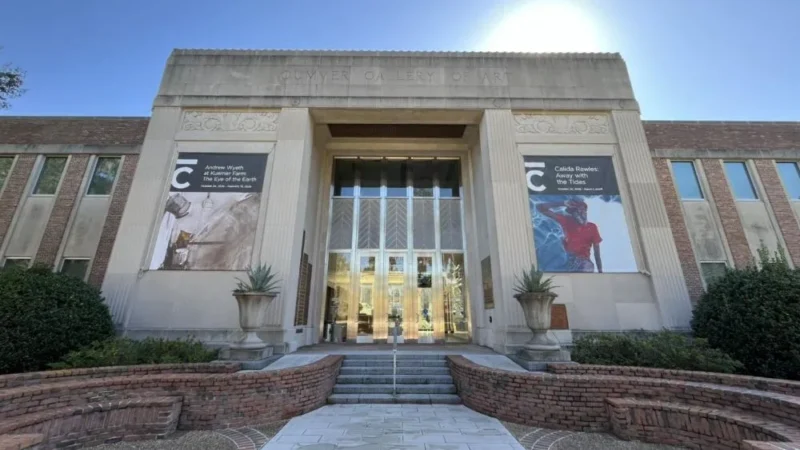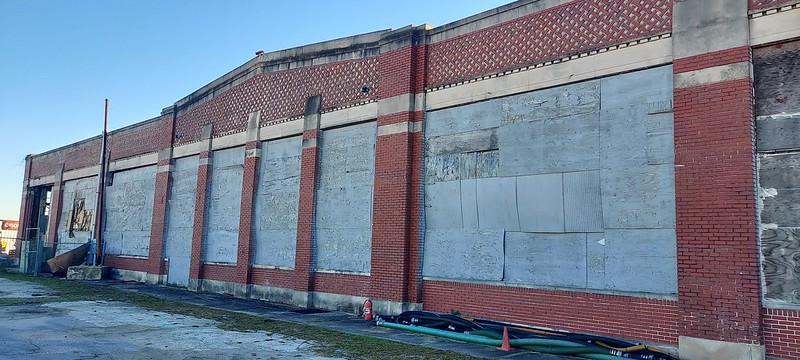
A major civilian and military port city, Jacksonville has been home to virtually every type of maritime industry over the years. Today, we take a look at five large shipyards that once laid down vessels on Jacksonville’s working waterfront.
A. Bentley & Sons Shipyard

Just north of Commodore Point, A. Bentley & Sons Co. shipyard was established in 1918 as a part of the U.S. Government’s Emergency Fleet Corporation’s attempt to develop concrete ships for World War I.
A major initial requirement of the EFC was to locate warm-water ports where speedy 12-month construction schedules could be followed on waterfront parcels in the range of 1,200 by 2,500 feet. With this in mind, Toledo-based engineering and contracting firm A. (Anderton) Bentley & Sons created a Jacksonville office, and their site was one of five selected with the expectation of building at least eight vessels, which could be outfitted on site in at least four ways. Other sites selected by the EFC were in Mobile, Alabama; San Diego and Oakland, California; and Wilmington, North Carolina.
Managed by James Bentley, the shipyard built 7,500-ton concrete tankers for the war effort. The country’s concrete ship experiment proved unsuccessful, however, and by the time it was canceled in 1921, just two ships had been launched from the shipyard. A few years later, the city of Jacksonville acquired the site, successfully selling the northern portion of it to Henry Ford for the development of the Ford Motor Co. Assembly Plant.
Gibbs Corp. Shipyards

Jacksonville pioneer George Williams Gibbs established the Gibbs Corp. Shipyards on the Downtown Southbank in 1908. Gibbs created a new engine that used half the fuel of others of the day and launched his company to lay down ships using the new technology. Located at what is now the DoubleTree by Hilton Jacksonville Riverfront Hotel, the Gibbs shipyard became a major employer during World War I and built 16 sub chasers for the U.S. Navy.
Gibbs had a substantial impact on the development of Jacksonville. The shipyard grew to encompass most of the Southbank riverfront between what’s now the Main Street Bridge and the Southbank Hotel Jacksonville Riverwalk. In 1924 Gibbs took over the struggling Florida Ferry Co. to operate a ferry connection between Downtown’s Northbank and Southbank. He also championed the construction of the Main Street Bridge, which put his ferry out of business when it opened in 1941 but added substantial value to the shipyard and other properties south of the river.
The Gibbs shipyard built many vessels for the U.S. Navy during World War II, including sub chasers, minesweepers, covered lighters and tugboats, as well as sea skiffs for the U.S. Army. It grew to become the largest shipbuilder in the South by the 1960s. In 1962, the Gibbs Corp. was sold to Jacksonville industrialist Bill Lovett along with several other shipyards. The Gibbs property became part of the Jacksonville Shipyards and then the Fruehauf Corp. By the mid-1970s, shipbuilding was in decline in the U.S, and Jacksonville’s shipyards were a casualty. Fruehauf shut down the Southbank’s old Gibbs yard and focused on expanding and upgrading their shipyard on the Northbank. The property then became a major focus of redevelopment efforts by Mayor Jake Godbold when he took office in 1978. Today, the former shipyard is a collection of hotels, office buildings and the Southbank Riverwalk.
Jacksonville Shipyards, Inc.

Jacob Brock opened the first shipbuilding operation during the 1850s on the site most known as the former Jacksonville Shipyards. After Brock’s death in 1877, the shipyards were sold to Alonzo Stevens. The Merrill-Stevens Engineering Co. was formed in 1887, when James Eugene and Alexander Merrill joined Stevens as business partners. By the early 20th century, the shipyard employed 1,500 and included the largest dry dock on the East Coast between Newport News and New Orleans. During this era, the barges used in the construction of the Panama Canal were constructed on-site.
During the 1950s, Merrill-Stevens sold the shipyard and relocated to Miami, where the company still builds yachts today. In 1963, new owner W.R. Lovett renamed the company the Jacksonville Shipyards, Inc. (JSI). By the time JSI was sold to Fruehauf Corp., it had become Jacksonville’s largest civilian employer, with a workforce of 2,500.
JSI’s decline began in the 1980s, shutting down briefly in 1990, laying off 800 workers. It would reopen briefly, only to close permanently in 1992 after selling its drydocks to a shipyard in Bahrain. Much of this former industrial site is planned to be transformed into a riverfront park and cultural district.
Merrill-Stevens Shipbuilding Co.

With building ships to transport troops overseas a major government priority, Downtown Jacksonville’s Merrill-Stevens Shipbuilding Co. was awarded large contracts to assist in the war effort. To meet those needs, Merrill-Stevens developed an 80-acre shipyard along Atlantic Boulevard, just east of Kings Avenue.
By 1918, a critical housing shortage for the shipyard’s workers had emerged. To address the issue, the U.S. Shipping Board authorized the construction of a $750,000 housing project on a 48-acre tract of land between Hendricks Avenue and Kings Avenue. Now considered to be a part of San Marco, the shipyard’s housing project was named Fletcher Park, in honor of Sen. Duncan U. Fletcher. During its time in operation, the South Jacksonville shipyard completed 25 ships for the war effort.
In 1949, the former shipyard became the site of Central Catholic High School. In 1953, the school was re-dedicated in honor of Bishop William J. Kenny, the first American-born bishop of the Diocese of St. Augustine.
St. Johns River Shipbuilding Co.

Shortly after the opening of Ford’s plant, Jacksonville’s economic prosperity ended with the burst of Florida’s real estate bubble during the mid-1920s. Shipbuilding in this area of the Downtown riverfront would once again bring economic growth back to the region.
With the country involved in World War II and taking advantage of a $17 million U.S. Maritime Commission investment, East Bay Street’s Merrill-Stevens established the St. Johns River Shipbuilding Co. in 1942 with an initial workforce of 258. This shipyard was located east of Hogans Creek and south of East Adams Street. Between 1942 and 1945, 82 liberty ships were produced at this site to transport troops and supplies across the globe. In 1944, it employed over 20,000 workers. When the war was over, so was production at St. Johns River Shipbuilding Co.
After the war, the property was taken over by the Duval Terminal Co. and utilized for a variety of industrial uses. Businesses once operating at this site, which went north to Adams Street, included Sinclair Refining Co., Southern Industries Co., the WFGA TV Studios, Merrill-Stevens St. Johns Division and the Mid-States Steel & Wire Co.
This heavy industry resulted in the Hart Bridge Expressway’s Northbank path’s construction as a viaduct between Commodore Point and Liberty Street. The expansion of the Gator Bowl for the Jacksonville Jaguars in the 1990s converted most of this property into parking lots and Gator Bowl Boulevard, south of what is now TIAA Bank Field. A Four Seasons Hotel & Residences is now being developed on this former shipyard site.







